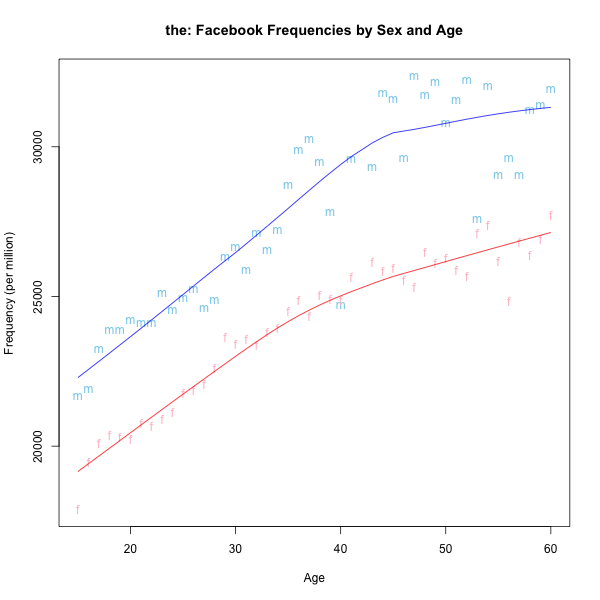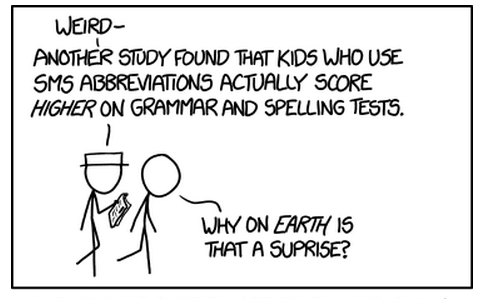Archive for Psychology of language
Pre-filled-pause lengthening
It's well known that syllables and words are longer before silent pauses, other things equal. It makes sense that syllables and words would also be longer before filled pauses (UH and UM), but I haven't seen this explicitly noted or quantified. For a course assignment, I recently prepared an R-accessible version of Joe Picone's manually-corrected word alignments for the Switchboard corpus (done when he was at the Institute for Signal and Information Processing at Mississippi State) — and so for this morning's Breakfast Experiment™, I thought I'd take a quick look at pre-filled-pause lengthening.
Read the rest of this entry »
Buzzfeed linguistics, presidential pronouns, and narcissism revisited
John Templon, "No, Obama’s Pronouns Don’t Make Him A Narcissist", BuzzFeed News 10/19/2014:
Conservative commentators are fond of pointing to Barack Obama’s excessive use of the word “I” as evidence of the president’s narcissism. (“For God’s sake, he talks like the emperor Napoleon,” Charles Krauthammer complained recently.) But there’s one tiny problem with this line of reasoning. If you’re counting pronouns, Obama is maybe the least narcissistic president since 1945.
BuzzFeed News analyzed more than 2,000 presidential news conferences since 1929, looking for usage of first-person singular pronouns — “I,” “me,” “my,” “mine,” and “myself.” Just 2.5 percent of Obama’s total news-conference words fell into this category. Only Herbert Hoover and Franklin D. Roosevelt used them less often.
Read the rest of this entry »
Inches
The headline above this page at TheHill.com says Warren inches away from Obama. And Bob Ayers, who pointed it out to me, was surprised that anyone would judge Elizabeth Warren to be that close to Obama on the issues, since they disagree quite a bit. I agree with Bob: I also read the sentence that way (the wrong way) at first. But if you read the text you soon see that they must have meant inches as a 3rd-person-singular verb, not a plural noun, and that reverses the key entailment. She isn't a mere few inches away from the president; she is edging away from him.
Read the rest of this entry »
Permalink Comments off
More fun with Facebook: THE
The script that I used to make that course assignment about Facebook pronouns ("Sex, age, and pronouns on Facebook", 9/19/2014; "More fun with Facebook pronouns", 9/27/2014) can trivially be focused on any other words — so here's "the":
Read the rest of this entry »
Um, there's timing information in Switchboard?
We start with a psycholinguistic controversy. On one side, there's Herbert Clark and Jean Fox Tree, "Using uh and um in spontaneous speaking", Cognition 2002.
The proposal examined here is that speakers use uh and um to announce that they are initiating what they expect to be a minor (uh), or major (um), delay in speaking. Speakers can use these announcements in turn to implicate, for example, that they are searching for a word, are deciding what to say next, want to keep the floor, or want to cede the floor. Evidence for the proposal comes from several large corpora of spontaneous speech. The evidence shows that speakers monitor their speech plans for upcoming delays worthy of comment. When they discover such a delay, they formulate where and how to suspend speaking, which item to produce (uh or um), whether to attach it as a clitic onto the previous word (as in “and-uh”), and whether to prolong it. The argument is that uh and um are conventional English words, and speakers plan for, formulate, and produce them just as they would any word.
And on the other side, there's Daniel C. O'Connell and Sabine Kowal, "Uh and Um Revisited: Are They Interjections for Signaling Delay?", Journal of Psycholinguistic Research 2005:
Clark and Fox Tree (2002) have presented empirical evidence, based primarily on the London–Lund corpus (LL; Svartvik & Quirk, 1980), that the fillers uh and um are conventional English words that signal a speaker’s intention to initiate a minor and a major delay, respectively. We present here empirical analyses of uh and um and of silent pauses (delays) immediately following them in six media interviews of Hillary Clinton. Our evidence indicates that uh and um cannot serve as signals of upcoming delay, let alone signal it differentially: In most cases, both uh and um were not followed by a silent pause, that is, there was no delay at all; the silent pauses that did occur after um were too short to be counted as major delays; finally, the distributions of durations of silent pauses after uh and um were almost entirely overlapping and could therefore not have served as reliable predictors for a listener. The discrepancies between Clark and Fox Tree’s findings and ours are largely a consequence of the fact that their LL analyses reflect the perceptions of professional coders, whereas our data were analyzed by means of acoustic measurements with the PRAAT software (www.praat.org). […] Clark and Fox Tree’s analyses were embedded within a theory of ideal delivery that we find inappropriate for the explication of these phenomena.
Read the rest of this entry »
Heart-mind
This is another one of those posts that I wanted to write long ago (actually almost a year ago), but it got lost in the shuffle until now, when I found it going through my old drafts.
It was prompted by an article that Christine Gross-Loh wrote for The Atlantic (October 8, 2013) titled "Why Are Hundreds of Harvard Students Studying Ancient Chinese Philosophy? The professor who teaches Classical Chinese Ethical and Political Theory claims, 'This course will change your life.'"
Read the rest of this entry »
Evaluating terminological oppositions
In "Biomedical nerdview", I noted that the terms "sensitivity" and "specificity" seem to be hard even for biomedical researchers to remember, and also denote concepts that are deeply misleading from the perspective of patients and their physicians. I offered a "flash of insight" about why researchers chose to focus on the concepts — they're relevant to public health concerns, though not to patients — but I confessed to being baffled about the hard-to-remember choice of terminology. Bob Ladd responded by email:
While not wanting to take away anything from your flash of insight, I was wondering if you wanted to write another LL post, not about nerdview, but about inexcusably unmemorable terminology for related concepts that have to be sharply distinguished from one another.
Since Bob goes on to suggest an interesting morpho-phonological theory about why some terminological oppositions are so problematic, I got his permission to post his note.
Read the rest of this entry »
"Judgement of error"
Sent in by M.C. — Fiona Simpson, "Breast-feeding mother asked to 'cover up' with dirty dishcloth at Bexleyheath pub", News Shopper 9/24/2014:
An outraged mother has organised a 'boob and bottle' protest at a Bexleyheath pub after being 'ordered' to cover her breast-feeding baby with a dirty dishcloth.
Mother-of-four Olivia Pozniak was breast-feeding her 11-week-old son, Louie, at the Furze Wren pub, owned by Wetherspoon, in Market Place on September 21 when she was asked to cover up.
An admirably straightforward apology ensued:
Wetherspoon spokesman Eddie Gershon said: "We apologise wholeheartedly to the lady. This should never have happened.
"Our pubs are welcoming to mothers who wish to breastfeed their children.
"The Wetherspoon staff member made a judgement of error in this case.
"There are no excuses and we do not offer one.
"We completely understand that this incident upset the lady in question and hope she accepts our apology."
The point of linguistic interest is the phrase "judgement of error", which M.C. suggests is a sort of phrasal malapropism for "error of judgement".
Read the rest of this entry »
"Quasiregularity and its discontents"
Suggestion for your weekend reading: Mark Seidenberg and David Plaut, "Quasiregularity and Its Discontents: The Legacy of the Past Tense Debate", Cognitive Science 2014. The abstract:
Rumelhart and McClelland’s chapter about learning the past tense created a degree of controversy extraordinary even in the adversarial culture of modern science. It also stimulated a vast amount of research that advanced the understanding of the past tense, inflectional morphology in English and other languages, the nature of linguistic representations, relations between language and other phenomena such as reading and object recognition, the properties of artificial neural networks, and other topics. We examine the impact of the Rumelhart and McClelland model with the benefit of 25 years of hindsight. It is not clear who “won” the debate. It is clear, however, that the core ideas that the model instantiated have been assimilated into many areas in the study of language, changing the focus of research from abstract characterizations of linguistic competence to an emphasis on the role of the statistical structure of language in acquisition and processing.
Read the rest of this entry »
Can you spell "bus"?
I have commented before on the psycholinguistics of signs painted on roads: in the USA it is apparently assumed that drivers will read the words in the order in which their front wheels reach them, so that what appears to be a display with "ONLY" above "LANE" above "BIKE" is supposed to be read as "BIKE LANE ONLY".  In the UK, the opposite assumption is made: that drivers will read the whole display as a text that starts at the top. However, in one startling recent case in Bristol, south-west England, the people who painted the sign on the road warning of a bus stop never read it at all, in either order. They just stencilled "BUP STOP" on the roadway and packed up and left. Photographic evidence supplied herewith, just in case you cannot believe anyone capable of holding down a local government job could be unable to spell "BUS".
In the UK, the opposite assumption is made: that drivers will read the whole display as a text that starts at the top. However, in one startling recent case in Bristol, south-west England, the people who painted the sign on the road warning of a bus stop never read it at all, in either order. They just stencilled "BUP STOP" on the roadway and packed up and left. Photographic evidence supplied herewith, just in case you cannot believe anyone capable of holding down a local government job could be unable to spell "BUS".
Permalink Comments off
More on UM and UH
A few days ago ("Fillers: Autism, gender, and age" 7/30/2014), I noted an apparent similarity between male/female differences in UM/UH usage, and an autistic/typical difference reported in a poster by Gorman et al. at the IMFAR 2014 conference.
This morning I thought I'd take a closer look at the patterns in a large published conversational-speech dataset. Executive summary:
- There is a large sex difference in filled-pause usage, favoring males by about 38%
- There is an enormous sex difference in UM/UH ratio, favoring females by about 310%
- These sex differences are mainly driven by the difference in UH usage, which favors males by about 250%
- Older speakers use UH more and UM less, resulting in a large decrease of UM/UH ratios
The general pattern of gendered filled-pause usage in English has been at least partly replicated in several other datasets, including the spoken part of the British National Corpus, but the details are sometimes quite different. (See my earlier post, and planned future posts, for some discussion.) But all the important questions remain open, for example:
- Are the sex effects due to functional, iconic, or physiological differences between UM and UH, or are they arbitrary gender markers?
- Do the age effects reflect a change in progress, or a life-cycle effect (e.g. due to changes in sex hormone levels)?
- Are the patterns the same or different across geographical, socio-economic, and ethnic varieties of English?
- Are there analogous phenomena in other languages?
Read the rest of this entry »

